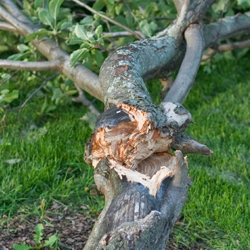Winter wind is mysterious…You can’t see it but it can cause two types of damage. One is obvious. The force of the wind breaks branches, tears leaves and knocks down trees. The second is more insidious, it can kill plants and trees by drying the roots! Wondering how?
Plants have a circulation system. The roots take up water and nutrients. To explain it in simple terms, the nutrients and water moves through the plant via the xylem and phloem. As part of the normal system, evaporation occurs from the leaf surfaces. This is “transpiration.” However, winds blowing across the leaves increase the transpiration rate. This increases the plant’s need to take up more water via the roots and move it through the plant to avoid wilting and drying. However, at the same time, the wind also evaporates moisture from the soil, further reducing the available moisture from the soil. Then, as temperatures fall, available moisture again decreases. If no water is available and if the roots dry completely, they will not be able to take up moisture when it finally becomes available. This death happens slowly. Sometimes it’s not apparent until spring.
What to do about these situations?
Deflecting the Wind
Solitary plants are most susceptible to wind force damage because of their exposure. To protect an at-risk specimen or a group of plants, consider building a temporary protective windbreak:
- Use jute or twine and gently bundle the branches of the specimen together.
- Drive four stakes into the ground around the shrub.
- Wrap burlap or sunshade cloth around the stakes to enclose the bundled plant.
Landscape planning can protect other plants. The way some houses sit on lots creates wind tunnels. In these situations, plant windbreaker plants or build a structure to deflect the wind. Windscreen plantings include hedge plants such as privets and deep rooted trees such as pines. Wind-deflecting structures include screen panels, fencing and lattice.
Preventing Moisture Loss
Several gardening practices reduce moisture loss during the winter.
The first is to use mulch to cover the soil. Mulching under plants retains soil moisture, evens soil temperature fluctuations and provides insulation to reduce the evaporative effects of the wind on the soil.
The second is a planned autumn watering and weeding system. Begin reducing the amount of water to deciduous trees as the leaves begin falling. This assists the tree’s transition to dormancy. After all the leaves have fallen, deeply water all plants to provide the maximum amount of water to the roots. Remove all weeds to reduce competition for soil moisture.
The third consideration is to not prune anything after early fall except broken or weak branches. Pruning prior to dormancy can cause a plant to produce new growth. This increases leaf surface and possible moisture loss.
There are also products to reduce transpiration such as Wilt Stop. It’s a natural nontoxic product, made from pine resin, and coats the leaves to reduce the transpiration process. Some also use this product on Christmas trees to prevent wilt inside the house and during transplanting to reduce transplant shock.
Summary
Mulch and water your garden in the fall. Later, listening to weather reports and being prepared to take action can save your prized plants. A few minutes now can save you many future dollars in replacement costs. If you need assistance, your garden center can answer questions and make product suggestions.




